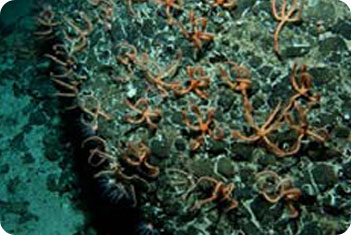If you don’t like creepy-crawlies, then you might want to avoid the undersea mountain chain known as Macquarie Ridge. One of its peaks is covered with tens of millions of brittlestars -- relatives of starfish and sea urchins that look like fat, five-legged spiders.
 Brittlestars at Macquarie Ridge. Credit: NIWA / CenSeam / CoML New Zealand National Institute of Water & Atmospheric Research, Census of Marine Life
Brittlestars at Macquarie Ridge. Credit: NIWA / CenSeam / CoML New Zealand National Institute of Water & Atmospheric Research, Census of Marine LifeMacquarie Ridge stretches from New Zealand southward to the Antarctic Circle. Some of its peaks -- known as seamounts -- reach to within about 300 feet of the surface.
Scientists discovered the brittlestars atop one of those peaks last year -- hundreds of them in every square yard, living armtip to armtip. The scientists nicknamed their find “Brittlestar City.”
Large aggregations of brittlestars are found all around the world. But this is the first one seen atop a seamount -- the others are on the ocean floor.
Scientists believe that this colony is made possible by a swift current that whips across Macquarie Ridge. The current actually circles the entire planet at around 40 degrees south latitude.
At Brittlestar City, though, the current is unusually swift -- about two and a half miles an hour. It’s accelerated by the contours of the ridge itself, which forces the current through some narrow gaps.
The current carries an abundance of food. The brittlestars just have to raise their wiggly arms into the current and let the food come to them. The current also keeps away fish that might compete with the brittlestars -- or even eat them. That makes the seamount a perfect home for a colony of creepy-crawly brittlestars.

